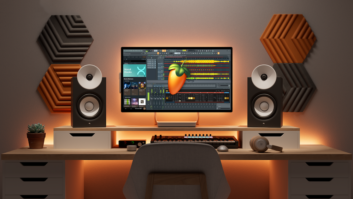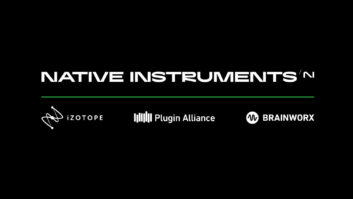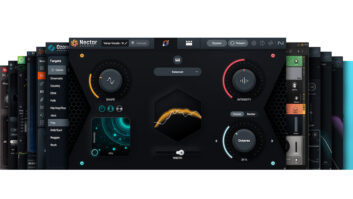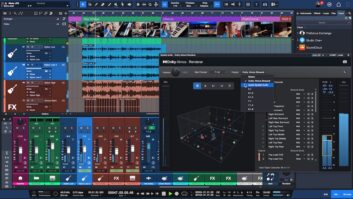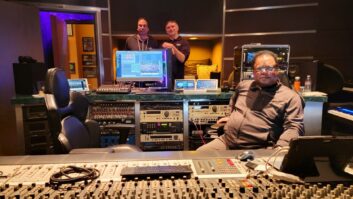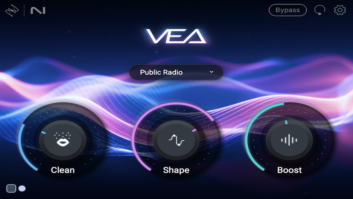
Berlin-based Native Instruments is known for its innovative approachto software synthesis, with unique sound creation tools that appealacross the professional spectrum, from producer to sound designer toDJ. The company recently released upgrades of two of its most popularapplications, Absynth 2 and Reaktor 4. Both are reviewed here; first,we’ll take a look at Absynth.
HAVE A LITTLE SHOT OF ABSYNTH
Absynth is a quasi-modular synth created by Brian Clevinger. Version1.x has become one of the most popular instruments in the world, but ifyou haven’t toyed with it yet, allow me to explain. It’s conventionalin some ways and unconventional in others. It has three doubleoscillators, each with a big collection of waveforms and a Double mode,in which the two elements are mixed, frequency-modulated orring-modulated. Your own hand-drawn waveforms are available to you inaddition to the factory presets and imported samples. Granularsynthesis can be used to modify your samples, too. Absynth sportsconventional but high-quality filters and LFOs for modulation of manyparameters.
Envelopes are one of Absynth’s more unconventional features. Up to68 breakpoints can be drawn in, and because the envelopes can besynched to tempo, a snap-to-grid feature is available, as well. Anotherunconventional feature is the Waveshaper, which adds nonlinear warmthand punch to your sound. There’s also an unorthodox effects section,which offers traditional delays, but the Pipe feature is the real news:It enables swirling, Doppler-esque motion, and really adds to thetimbre.
ABSYNTH 2.0: A NEW FLAVOR
Absynth 2.0 ($299, upgrades range from free to $99) debuted almost ayear ago. A major new feature in the revision is OS X compatibility,although Absynth is a cross-platform product, having been available forWindows for quite some time now. As with numerous other apps, portingAbsynth to OS X brings compatibility with CoreAudio, which results inmuch higher efficiency and quality. Latency is reduced, and CoreMIDI isnow implemented in the app, as well. Other good news: Previous versionsallowed you to import a tiny piece of a sample, but 2.0 facilitates theimport of any-sized sample you like for further tweaking with Absynth’spowerful modules. Don’t think of it as a sample player, though. Iplayed with this feature and discovered that it’s a great way to inventnew timbres and textures.
A Sample Jump feature allows you to retrigger from any point in youruser-developed envelope. This can be very interesting for liveperformance. Granular sampling has also been added. Various parametersof the Granulation algorithm such as the grain length or density can bemodulated, which can create wild textures. For that matter, nearly anyparameter can be assigned a continuous controller, and I achieved somevery innovative sounds by modulating these parameters; sound designerswill love this. I introduced a sample of an ARP synth string sectionand tweaked the granulation to arrive at some downright frighteningsounds. (Absynth was used extensively in the Matrix Reloadedsoundtrack, by the way!) Synchronization to the host is included, andeffect times, LFOs and envelopes can now be automatically synched withsong tempo. (Absynth 1 users had to attempt this type of syncmanually.) I love being able to easily create loops with very specifictimbres that can be creatively modulated. It has profoundly impactedthe way I think about loops.
Clevinger’s superpowerful 68-point envelope has been one ofAbsynth’s most attractive features since V. 1, but now becomeseminently more powerful with new control modes in V. 2. Incontrol-driven mode, a MIDI controller now has the ability to modifyenvelopes. In Link mode, multiple envelopes can be linked together. Bylinking to the master envelope, you can affect tweaks that have auniversal effect. Say you’ve developed a loop and you want to make thewhole thing brighten over the course of four bars. This new featureenables you to create a swelling envelope four bars in length andeffectively “add” it to the existing envelope, assigned tofilter cutoff. The result is that your original filter modulation justgets brighter over those four bars.
LFOs can now be introduced and microscopically edited in envelopes.I found this feature handy for creating rhythmic features in myenvelopes. Envelope breakpoints can also be affected by MIDIcontrollers, and the envelopes themselves can now control many newparameters. At a more fundamental level, the filters have been improvedto sound better, and the oscillators have a new anti-aliasing mode thatmakes the waveforms superrealistic throughout the frequency range. Byswitching the anti-aliasing mode on and off, I found different anduseful timbres, because even aliasing creates an interesting digitaljitter. Of course, it’s also nice to turn the anti-aliasing on whenyou’re trying to emulate more traditional synth sounds. Each oscillatoris independent in the stereo image, resulting in really cool sounddesign. I was able to create very wide stereo patches that exhibitmotion in the stereo field. And, of course, this can be exacerbated bythe effects section. Version 2 also includes 128 new presets. It bearsmention that many, if not most, of the upgrades in V. 2 areuser-motivated as they are based on feedback from the Yahoo Absynthuser group.
A SONIC SUPERSTAR
To the aforementioned features, add deep and comprehensive MIDIimplementation, a powerful note-scaling utility, user-defined tunings,and the fact that many parameters, such as waves, envelopes and thelike, can be stored in a library, and it becomes eminently clear thatAbsynth is much more than just another semimodular soft synth. Thefactory patches feature a boatload of very realistic acousticalinstrument sounds; a nice selection of traditional, subtractive,analog-style ploinky synthesizer sounds; ambient patches that play outand evolve over time; and even speech synthesis. This synth proves tobe a very complete tool kit for sound and patch design and presents aunique sonic flavor that’s not available elsewhere. There’s a reasonwhy Native Instruments was so keen to connect with Clevinger and makethis product one of the most sought-after soft synths in the world.

THE REAKTOR CORE
Reaktor is a powerful solution for anyone who wishes to create theirown software synthesizer, sampler, drum machine or signal processor.And that’s a bit of an understatement, in that Reaktor can do even morethan that. From a library of modules—oscillators, filters,envelopes, LFOs and various other modulators and mathematicaloperators—you can construct any design your brain can conceive.This might seem like overkill, but imagine how much better yourprevious projects could have been if you had the ability to develop aninstrument that behaved and sounded exactly as you wished. That’s whatReaktor does.
The fundamental building block in Reaktor is the module, and indeed,hundreds of modules ship with the product. Modules are developed frominstruments, which can, in turn, be combined into“ensembles.” For example, you could have a suite of analogdrum synths controlled by a sequencer. Ensembles can be stored andedited by anyone with the application. There is also a version of theproduct known as Reaktor Session, which essentially only lacks theability to design your own stuff. You can use any ensemble developed byanyone else. And there are a lot of ensembles available—well inexcess of 1,000. Almost any classic synthesizer you could want issuccessfully emulated by someone out there, and you can download themfrom Native’s Website and elsewhere.
THE NEW REAKTOR
Reaktor 4 ($499, upgrades ranging from $19 to $279) is the latestrevision of this world-class, “roll-your-own” virtual synthapplication. Among other things, V. 4 updates the application forApple’s OS X, which places the speed and quality of audio very high onthe priority list, and the result for Reaktor users is high-quality,low-latency audio. Reaktor 4 is compatible with Mac OS 9 and OS X;Windows 98 through XP; and VST 2.0, DXi, ASIO, AudioUnits, Core Audioand OMS interfaces.
Version 4 also offers improved VST support, enabling automation ofall parameters by your host sequencer, and Mac users finally havemultiple instances available, limited only by CPU overhead. It alsoimproves the way snapshots are handled, enabling morphing from onesnapshot to another (a very powerful feature) and randomization, whichis a nice sound design tool. You can create new patches by insertingrandomized values into the parameters. There is actually a dedicatedSnapshot window that free-floats on-screen and gives you the ability totake a snapshot at any given moment to preserve what you’re currentlydoing.
Version 4 integrates elements from the powerful sample-mappingtechnology from the company’s Kontakt sampler. Overlapping zones andcrossfades are not available as they are in Kontakt, but velocitysplits are. I’m a Kontakt user, but I find myself turning to Reaktorwhen I need to engage in wild, nontraditional twisting and bending ofmy samples. In V. 3, only 16-bit samples were usable; now, 32-bitsamples can be used. Another feature new to V. 4 is the anti-aliasingoscillator borrowed from NI’s Pro-53. Aliasing has been the bane ofsoft synth designers who are forced, de facto, to work in the digitaldomain. Higher resolution enables the elimination of the phenomenon,and it’s a very welcome improvement here, allowing for near-perfectemulation of traditional analog circuits. For that matter, NI shipsReaktor 4 with a whole new library of improved modules with the idea ofcreating the highest-quality sounds possible.
Version 4 also brings a grain-cloud granular delay module withfreezing and live sampling. This opens a whole new world for thegrowing number of people who use Reaktor in live situations. There area number of wonderful grain-oriented ensembles available.Traditionally, I have avoided working with granular synthesis becauseit was difficult to achieve usable results. However, with Reaktor, Icould create very useful and fresh timbres very quickly. It’s going tohave a profound impact on all of my future projects. Also available areadvanced filters, saturation and signal routing, as well as newmathematical functions and support for “C”-style codewriting for event processing. Open Sound Control (OSC) is supported,allowing multiple applications or even computers to communicate in amuch more sophisticated way than what is possible with MIDI.
There are also many new modules or improvements on existingversions. The user interface is enhanced, which makes operating Reaktormuch easier. There are many new graphic options, including the abilityto display image sequences. There is even a “Pong”ensemble, approximating the classic Atari game. Reaktor’s all-importanttoolbar has been streamlined and only takes up half as much verticalspace as before. Ensembles can be minimized on screen, which isimportant when many windows are open. Free-floating browser windows arealso implemented allowing for quick navigation.
COULD THIS BE THE FINAL WORD?
An issue to consider with Reaktor is CPU overhead. As one mightimagine, a sophisticated ensemble in Reaktor can chew up and spit outyour CPU, leaving only bones and gristle for other open applications.With my G4 dual 1GHz machine, Pro Tools got a little squirrelly (andactually crashed a few times) when I opened large, complicated Reaktorensembles, so be prepared with as much host horsepower as you canmuster. You might even consider a multi-CPU setup, dedicating acomputer to CPU-hogging soft synths.
So, is Reaktor the only synth you need? For the moment, otherproducts still exhibit quirky personality traits that Reaktor (or anyother roll-your-own synth product) cannot perfectly emulate. Don’t kidyourself, though—Native Instruments is knocking on the door. Themeticulous control over every tiny detail will get continually moresophisticated and microscopic, and eventually you’ll be able tosuccessfully knock off any existing product you’d like, given enoughtime and motivation. You can already build in things like thermal driftor noise. As computers and operating systems get faster and moreefficient, hardware will become obsolete, and I would submit thatReaktor is getting marvelously close to making this happen. One of theincluded ensembles is called Junatik, which is a revved-up version ofRoland’s classic Juno 6 (or 60, which has patch memory). I comparedJunatik parameter for parameter with my Juno-60, and it’s pretty muchsmack on the money, right down to the cheesy (and noisy) chorus effect.I’ll put it this way: Reaktor may not be the only synth that you need,but if you have a robust CPU, you won’t need much more.
Native Instruments USA, 323/467-5260, www.native-instruments.com.
John McJunkin is the principal of Avalon Audio Services inPhoenix, and is now struggling to convince his wife that he needs allthat space for real synthesizers when the virtual synths sound just asgood.
